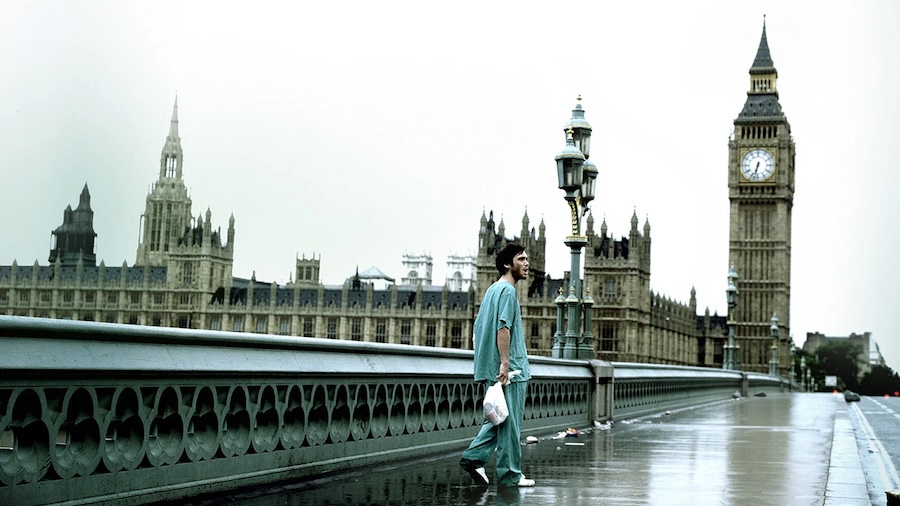
THE DAYS ARE NUMBERED.

Danny Boyle is emerging as one of the most interesting British directors of our time. Not only because he is obviously gifted, but also because his oeuvre is largely surprising and varied. After portraying Edinburgh heroin addicts in Trainspotting, crafting a star-studded comedy (A Life Less Ordinary) and turning Alex Garland’s popular backpacker novel “The Beach” into a movie, Boyle decided to take on George A. Romero. Well, that must have been his intention, because it’s virtually impossible to make a zombie movie without acknowledging the master of the genre.
Infected with a “rage virus”
The story was written by Garland, detailing the end of the British Isles as we know them. A gang of misguided animal rights activists attack a lab that is performing experiments on monkeys. The activists have no idea that the animals are infected with a “rage” virus, which is transmitted through blood. When the monkeys are released, they attack and bite the activists; twenty seconds later the gang turns into crazed flesh-eaters. 28 days later, Jim (Cillian Murphy) wakes up in a London hospital and discovers an empty city. The disease has spread rapidly, forcing a hasty evacuation, and the only ones who remain are infected flesh-eaters and a few survivors who have learned how to fight the ghoulish predators.
Jim hooks up with Selena (Naomie Harris), Frank (Brendan Gleeson) and his daughter, Hannah (Megan Burns). They get out of London and try to reach the outskirts of Manchester where it looks like a few still-healthy soldiers might be holed up.
Not without a sense of humor
The images of a deserted London, in this unpleasant film, were uniquely created and look remarkable. They’re followed by several dark and scary sequences where the protagonists face the worst of humanity, represented by the infected as well as those who hare not sick but have lost any qualities that once made them decent. That’s an important part of the story, the examination of what happens to us all when we encounter a crisis of unimaginable proportions. Some of us have no idea how to cope; others have an instinct to survive.
Danny Boyle uses silence, far more startling than sound effects.
Because they are still alive, the infected are not actually zombies but more like living dead. They have lost their sanity, bodies are rotting and unless someone kills them they will eventually starve to death. The scenes where they attack are interesting; Boyle uses silence, far more startling than sound effects, and the infected display unusually rapid body movement, which is quite intimidating. Whenever they show up, one is instantly reminded of classic moments from Romero’s work; that’s the right kind of homage. 28 Days Later is not without a sense of humor, which is welcome in a tale this grim, and there’s a lot of affection between the four survivors we end up rooting for. The actors make them real.
The film’s final 45 minutes offer moments when my interest in what’s going on flags. But this apocalyptic affair nevertheless shows Boyle’s talent. It’s not easy to make a film like this work, avoiding the roadblocks that might render it dull, depressing, predictable or ridiculous… but this director steers his ship in an unexpected direction.
28 Days Later 2002-U.S.-U.K. 112 min. Color. Directed by Danny Boyle. Screenplay: Alex Garland. Cinematography: Anthony Dod Mantle. Cast: Cillian Murphy (Jim), Naomie Harris (Selena), Brendan Gleeson (Frank), Megan Burns, Christopher Eccleston, Noah Huntley.
Trivia: Leonardo DiCaprio and Ewan McGregor were reportedly considered for the part of Jim. Followed by two sequels, starting with 28 Weeks Later (2007).
European Film Awards: Best Cinematographer.
Last word: “The London stuff at the beginning of the film was the biggest challenge. Although we didn’t have much money, we wanted to say: here’s a big film with a large agenda and with a huge landscape to look at. One of the problems with filming in Britain is that there’s this slightly depressing air of familiarity and scale, but we wanted to make it something mythic and give it a mythical size. We didn’t have enough money to pay for carnage on a city-wide scale, but the idea of an emptied London gave us the iconic image we needed.” (Boyle, BBC)
